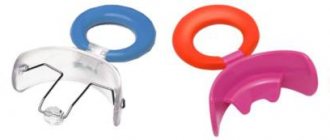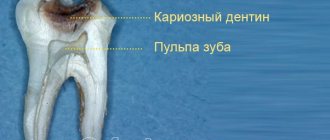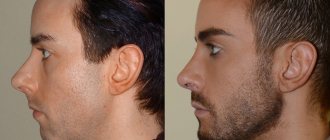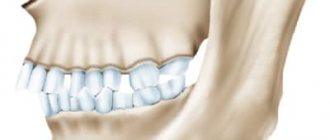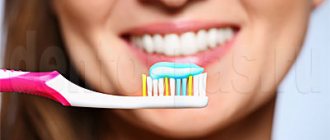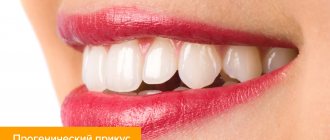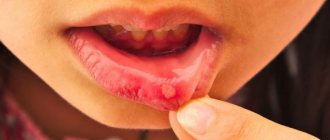3082
A correct bite is not only a beautiful smile, but also the key to the health of the entire body. Unfortunately, a significant number of people have an abnormal bite, which varies in severity and type.
One of the anomalies in the development of the dentofacial apparatus is a deep bite.
What is a deep bite?
People strived for a perfect smile back in ancient times, evidence of this is found in mummies from Ancient Egypt, which had ropes obtained from animal intestines entwined around their teeth.
They played the role of modern dental wires for braces. Now it is much easier to correct a deep bite. To achieve faster and more effective results, you need to start treatment from childhood. A deep bite is an anomaly that manifests itself in the form of overlap of the lower dentition with the upper one.
The defect can be diagnosed when there is an overlap of more than 1/3 of the height of the crowns. The “lucky” one with a deep bite experiences discomfort while chewing food, speech impediments, and injuries to the gums and palate.
Different braces - how long to wear?
Modern dentistry offers a huge selection of brace systems of various designs, made from different materials, with varying strength and aesthetic properties. All of these factors can affect the length of time you wear braces.
- Metal braces.
This system is considered the most durable and puts maximum pressure on the teeth. The main disadvantage is that these braces are noticeable to others and affect your appearance. On average, they are worn from one to one and a half years.
- Ceramic braces.
They look aesthetically pleasing, invisible to others, and have good strength. But they do not put as much pressure on the teeth as metal ones. Therefore, the period of wearing such braces is usually several months longer. On average it ranges from one to three years.
- Sapphire designs.
The characteristics are similar to ceramic ones; they are also worn for 1-3 years. But sapphire braces require especially careful care.
- Lingual braces.
They are installed on the inside of the teeth, which makes these braces invisible. The disadvantage is that when wearing them, a person may experience discomfort in the mucous membrane or tongue. On average, lingual appliances are worn for 1.5 to 2.5 years.
Causes of deep bite
Such an unpleasant phenomenon as a problem bite can appear both in childhood and in older age. In dentistry, there are several reasons that can lead to the development of pathology:
- birth defects associated with facial deformation;
- genetic inheritance of the specific structure of the dental system;
- improper dental prosthetics;
- delay in prosthetics.
Also, the causes of a deep, incorrectly formed bite can be constant finger sucking and lip biting. Even a pacifier can lead to the development of occlusion. The pathology does not go away on its own, but fortunately orthodontics is now very well developed, making it possible to effectively eliminate the manifestations of deep bite.
Other factors that affect the length of time you wear braces
The type of bite and the severity of the orthodontic defect are not the only factors that determine how long to wear braces. The following points also affect the timing:
- type of orthodontic structure;
- patient's age;
- individual characteristics of the body of a particular patient;
- quality of hygienic care for braces.
Classification of deep bite
According to the nature of origin, a deep bite can be:
- Primary – develops for reasons of irregular structure in the facial skeleton and dentition. The anomaly is most often represented by a deep blocking bite, which is manifested by limitation of jaw movements other than closing and opening. This pathological occlusion comes in two forms: dentoalveolar and skeletal deep bite.
- Secondary. The main reason for the formation of such a bite is due to previous diseases of the dental system. This could be periodontal disease, tooth loss, etc.
There is also a classification of deep bite according to the type of interaction of the lateral dentition:
- Distal - with this form of bite, the upper row of teeth overlaps the lower row by the length of the crown. The pathology is characterized by an underdeveloped lower jaw, a slightly sloping chin, a shortened face, and exposure of the crowns to the neck when smiling.
- Neutral - with such a bite, there are no pronounced defects in the skeletal structure of the face, its lower part is slightly shortened, and the chin is of a normal shape.
The stages of development of deep bite are divided into initial, progressive and traumatic.
Results
Deep bite has various causes, associated with both congenital anomalies and deviations that formed during a certain stage of life. There is a classification that distinguishes 3 types of this pathology: deep incisal overjet, deep bite and deep traumatic bite. They all have their own characteristics, which the orthodontist takes into account when prescribing treatment. Childhood forms of this disease are easier to correct than adult deviations of this type.
Common methods of treating deep bite: installing braces, aligners, trainers, aligners, plates, Herbst apparatus and even surgery. Each of these designs has a limited range of applications. Some forms of this pathology can be corrected only by one of the above methods or a combination of several.
If this disease is not detected and treated in a timely manner, it can lead to serious damage to the teeth (especially the enamel of the lower incisors), gums, soft tissues in the oral cavity, jaw muscles and joints. A professional dentist will help identify the problem at an early stage in childhood and make adjustments to the process of correcting malocclusion. The sooner you notice it and start fighting it, the more effectively and quickly you will get rid of it. There are quite effective preventive measures, the use of which at the initial stage of the development of a deep bite gives good results. Pay close attention to the hygiene and maintenance of the healthy condition of all elements of your child’s oral cavity! If this article was interesting to you and helped you understand the problem of forming and correcting deep bites, you can share it with relatives, work colleagues and friends. I hope you learned something new and informative on this topic and were able to find answers to your questions! Check out other materials on our blog, there is a lot of interesting stuff there.
Have a great day and stay safe!
Deep bite in children
The cause of deep occlusion can be birth trauma, a long period of sucking a pacifier or finger, late loss of baby teeth, calcium deficiency, or trauma to the dental system. In 15% of schoolchildren, a distal deep bite is diagnosed - the upper jaw is strongly pushed forward. It can develop against the background of impaired nasal breathing, adenoids, enlarged tonsils, frequent colds, and rickets. Also, improper formation of the bite can be caused by the removal of teeth at an early age, or the habit of propping up the chin.
Symptoms of deep bite
Externally, improper closure of teeth is manifested by shortening of the lower third of the face, the formation of a pronounced supramental fold, and turning of the lower lip outward. Among the oral signs:
- overlap of the lower frontal dentition with the upper one by the size of the crown;
- inflammatory process of the mucous membranes of the mouth;
- rapid erosion of tooth enamel, which leads to the development of caries;
- excessive overhang of the upper jaw over the lower jaw;
- decrease in the depth of the vestibule of the oral cavity.
Also, with malocclusion, secondary symptoms appear that develop against the background of the primary ones: problems with diction, breathing, deformation of the cranial vault, pain while chewing food.
Mesial bite: how long does it take to correct?
With such an anomaly in the closure of the teeth, the lower jaw protrudes forward, and the teeth of the lower row overlap the teeth of the upper one. Mesial occlusion significantly affects facial aesthetics. If the incisors of the two jaws do not meet, this can lead to problems with diction, speech and chewing.
It is impossible to slow down the growth of the lower jaw using dental methods. Therefore, with such a violation, the orthodontist most often decides to stimulate the growth and expansion of the upper jaw. To do this, braces are placed on the first molars and permanent incisors.
How long they are worn depends on various factors. For some, bite correction occurs after 1 year, for another patient it takes 2 years.
Diagnosis of deep bite
Occlusion can be determined by external signs, but not all forms of improper closure of teeth are pronounced, so additional diagnostics are required. The specialist examines the patient’s medical history and conducts a visual examination of the oral cavity. The following activities can be carried out:
- taking an impression with alginate mass, followed by making diagnostic models and measuring them;
- photo of the face in profile and front;
- X-ray examinations;
- measurement of dental arches, apical base;
- performing an occludogram.
When making a diagnosis, data obtained from the results of electromyography, orthopantomography and teleradiography play an important role.
Surgical method
This method is used when others do not give results and the bite needs to be corrected in a short time. Surgery is used in very severe cases.
This method allows you to very noticeably transform a person’s face. The patient's external contour is transformed and becomes more attractive.
Surgical intervention is used:
- with an open bite in the area of the front teeth;
- with irregularities in the shape of the chin;
- in case of violation of facial symmetry as a result of an accident;
- with a deep bite, which appeared as a result of inheritance from parents.
The surgical operation is complex and difficult to perform, and expensive.
Consequences of deep bite
Elimination of deep occlusion is necessary not only to achieve an aesthetic result, but also to treat phenomena that bring a lot of discomfort in everyday life. Teeth that do not fit properly can cause the development of speech defects, facial asymmetry, and various aesthetic deviations. Besides:
- a large load on the front teeth provokes increased sensitivity and rapid abrasion of the enamel, which leads to caries;
- Loose teeth and frequent inflammatory processes in the gums appear against the background of their constant injury.
The pathology also leads to a decrease in the height of the bite, headaches, tooth wear and subsequent loss of tone of the masticatory muscles.
Complications
Reduced bite is a rather dangerous pathological condition. If nothing is done, serious complications arise.
The following problems begin:
- violation of diction;
- high load on the incisors;
- facial disproportions;
- inflammatory pathologies of the gums;
- pathological mobility of teeth;
- trauma to the oral mucosa;
- breathing and swallowing problems;
- headache;
- dysfunction of the maxillary joint;
- pathological abrasion of incisors.
All these complications can provoke numerous complexes in the child and complicate his relationships with peers.
Treatment of deep bite
For deep bites in adults, braces are usually used. A very interesting fact is that for the manufacture of certain types of braces, nickel-titanium is used - a material created by NASA for use in space. Clear aligners can also be used, which are more aesthetically pleasing. In addition, they are convenient, as they can be removed when eating or brushing your teeth. It takes at least 12-14 months to correct improper closure. The effectiveness of treatment and its duration depend on the degree of pathology and the correct choice of orthodontic design. To achieve a good result, it is important for the patient to comply with the rules established by the treating dentist. Treatment of deep bite in children is simpler, since the dentition is not yet fully formed; the course of occlusion can be influenced by the following methods:
- the child needs to be accustomed to solid food in order to create optimal stress on the teeth;
- it is important to cure dental caries;
- during the change of baby teeth, plates or other orthodontic structures (Frenkel, Bruckle, trainers) are installed on molars;
- At the age of 12 years, vestibular and lingual braces can be installed.
The iOrtho network of clinics selects the most effective treatment method taking into account the specific situation. We provide high-quality services and a modern treatment method using Invisalign aligners. Book your consultation now to enjoy a beautiful smile in just a few months.
Treatment errors
When turning to inexperienced specialists, you may be faced with the selection of the wrong treatment method. If there is a mistake in choosing devices such as occlusal pads, crowns, mouthguards for children, their large molars and incisors may become separated. This leads to rapid erasure of the cusps on the antagonist teeth located in the lateral row. In the anterior part, on the contrary, there is a sharp separation of the teeth and their protrusion forward, worsening the incisal overlap.
Deep bites in adults and teenagers can only be completely corrected if there is enough space underneath. Once the jaw has formed, some teeth will need to be removed to gain sufficient space. You also need to take into account the fact that when removing tooth protrusion in the anterior part of the dentition, the incisal overlap increases.
The effectiveness of treatment using the Herbst apparatus
Deep overbites are often corrected using the Herbstat appliance, a permanent orthodontic appliance. To correct the occlusion, it must be worn for at least 3-12 months. Its main task is to restrain the growth of the upper jaw, correct the lower jaw, and rebuild the functioning of the muscles of the dental system. The choice of this treatment method allows you to accurately predict the result and achieve it in a short time. The device does not interfere with eating or talking.
Treatment methods in adults
In adults, correction of deep bites is carried out using braces of any type. If the patient is unwilling or unable to wear an orthodontic structure, the patient can have veneers installed, which only cosmetically eliminate the defect.
Also, prosthetics using implantation is considered as an alternative, but expensive method. This procedure has a lot of contraindications, but effectively eliminates abnormal bite development.
Duration
The longest method is correction using braces . To obtain visible results, the patient will have to wear braces for about 6 months .
2 to 3 years to achieve final correction .
Retention period
After removing the system, in order to consolidate the effect obtained, it is necessary to use retainers for as long as the braces are worn.
For this purpose, two types of retainers are used:
- Individual mouthguards of removable type.
- Fixed arc , fixed to the problem area using special glue.
Forecast and prevention of deep bite
The prognosis of a deep pathological bite when choosing the right treatment method is always positive. It is possible to correct incorrect teeth closure even in adulthood, but in order for the result to be of better quality, treatment must begin in the first stages of its development. Prevention is also important, it is necessary to control the loss of baby teeth and the correct growth of molars, monitor the position of the child’s head during sleep, protect him from bad oral habits, in particular prolonged sucking of a pacifier and thumb, it is important to promptly treat ENT diseases and other pathologies that can cause the development of a deep bite.
These include:
- prolonged sucking of a pacifier and foreign objects (pencil, finger);
- bad habits (biting your lip, resting your chin on your hand);
- early loss of molars;
- pathology of ENT organs;
- abnormalities of the musculoskeletal system;
- severe caries of molars;
- skull injuries;
- malignant tumors of the skull bones;
- consequences of rickets;
- inflammatory diseases of the jaw bones;
- untimely teething;
- defect in the attachment of the frenulum of the lips and tongue;
- congenital anomalies of the facial skeleton.
It is necessary to identify the cause of the development of the pathology; corrective measures depend on this.
